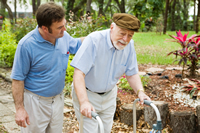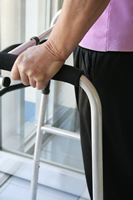Changes in Body Function

The physical effects of stroke can range from muscle weakness to total paralysis. The physical effects will depend on where and how the stroke injured the brain.
What Do You Need to Know About Paralysis and Weakness?

Paralysis
Paralysis is when muscles are unable to move on their own. There is often a loss of feeling. Paralysis in the arm or leg is the most common problem. If one side of the body is paralyzed, it is called hemiplegia.
Weakness
Weakness means a lack of strength. When muscles are weak, they do not move as easily. Muscles may feel heavy or numb. Weakness affecting one whole side of the body is called hemiparesis.
Rehabilitation
Rehabilitation (rehab) helps strengthen weak muscles. It helps stroke survivors who have hemiparesis regain some movement. Most importantly, rehab teaches your loved one how to deal with the changes. Rehab will help your loved one achieve the best quality of life. Learn more about stroke rehabilitation.
Treatments
New treatments are also being developed. One treatment is electrical stimulation. This treatment sends small electrical charges to the muscles. These electrical charges improve muscle strength and function.
Constraint-induced movement therapy (CIMT) is another new treatment. CIMT involves restricting movement in the unaffected arm or the arm with normal strength. Then, the stroke survivor is forced to use the weak or affected arm. The American Stroke Association Web site has more information on CIMT. You can find a link in the Resources section.
How Can Stroke Affect Problems with Balance?
Your loved one may have trouble with balance after stroke. He or she may feel dizzy or unsteady. This can cause your loved one to lose confidence in walking. Falls often happen after stroke. Almost half of survivors suffer a serious fall in the first year. It is important that your loved one be evaluated for risk of falls. Learn more about preventing falls after stroke.
Balance problems can be treated. Have your loved one evaluated by a physical therapist. Exercises, such as yoga and tai chi help to improve balance. The Stroke Association has a fact sheet on their Web site about balance problems. You can find a link in the Resources section.
How Can Stroke Affect Sensations or Feeling?
Your loved one may experience a change in sensations. Sensations can be decreased or be felt more strongly. Sensations may also be painful. Unpleasant feelings, like “pins and needles” may occur. These sensations often lessen over time. Some survivors report that sensations are worse when they are tired. Getting plenty of rest will help your loved one.
Safety is a concern for those with decreased sensations. The risk of falls and other injuries is greater. To prevent burns, test water temperature before bathing your loved one. Check affected limbs for bruises, cuts or sores. Make sure to change positions regularly to prevent pressure sores. Talk to your healthcare team about other safety tips.
What Is Spasticity?
Spasticity is a condition where muscles become stiff or rigid. Movement is limited. Over time, the muscle may shorten permanently. When the muscles shorten, the joints can “freeze” into position. This is a painful condition called a contracture. Contractures prevent normal movement and interfere with doing daily tasks. Proper positioning of spastic limbs can prevent contractures. The physical therapist can teach you proper positioning.
Treatment for spasticity includes other types of physical therapy like exercise and stretching. The goals of treatment are to relieve symptoms, reduce pain and improve movement. Learn more about spasticity.
What Is Foot Drop?
Stroke can weaken the muscles that help lift the foot. This will cause the toes to drag when walking. Some survivors try to help this by bending the knee to lift the foot higher. This uses more energy and makes walking harder.
Your loved one can be fit with a brace or shoe insert. This will make walking more comfortable. Talk to the physical therapist about gait training exercises. These exercises help your loved one relearn how to walk safely. In some cases, surgery may be needed.
What Is Fatigue?
Many stroke survivors feel very tired or have fatigue. Simple tasks, like sitting up or standing may be exhausting. Fatigue can slow down your loved one’s recovery. The good news is that there are treatments and ways to decrease fatigue. Physical and occupational therapy can help. Learn more about fatigue.
How Can Assistive Devices Help Your Loved One?
 Ask your healthcare team about assistive devices. These include wheelchairs, canes and walkers. The VA provides assistive devices to Veterans. Agency supportive services can be arranged if needed. A VA social worker or nurse can help answer your questions.
Ask your healthcare team about assistive devices. These include wheelchairs, canes and walkers. The VA provides assistive devices to Veterans. Agency supportive services can be arranged if needed. A VA social worker or nurse can help answer your questions.
Assistive devices:
- Help your loved one move around easier
- Provide support and balance
- Help prevent falls
- Helps your loved one be more independent
Some survivors may not want to use assistive devices. They may be embarrassed or afraid. Talk to your loved one about his or her feelings. Learn more about assistive devices.
Helpful Tips
Watch for things that can cause falls when walking – Uneven sidewalks, door steps, liquid spills, ice and pets can cause falls.
Help your loved one stay active – Work with your healthcare team to develop an exercise plan.
Attend rehab sessions as often as possible with your loved one – This will keep you informed of their progress. Ask questions and talk to the rehab team about your concerns.
Listen and be supportive – The physical effects of stroke can be mentally and physically stressful. Allow your loved one to express their feelings.
Remember
- Have your loved one evaluated for risk of falls. Falls are common after stroke.
- Think about finding rehabilitation (rehab) services for your loved one. Rehab can help stroke survivors achieve the best quality of life.
- Encourage your loved one to exercise. Exercise builds strength and improves movement. Contact a physical therapist to set up an exercise program for your loved one.
- Think about getting assistive devices like walkers or canes for your loved one. Assistive devices can help your loved one be more independent.
Other Resources 
Additional credible resources on this topic can be found here. Website pages may change or update, therefore if a link does not work, you may also try to type the information into your internet search bar. This Resource List will be updated frequently.
|
*Link Disclaimer: Links to information and Web sites outside of the Department of Veterans Affairs do not indicate an endorsement of products or services offered by the sites. In addition, these sites may have privacy and security policies that are inconsistent with those of VA. |
References: National Stroke Association. (2008). Retrieved February 2, 2009, from: http://www.stroke.org/site/PageServer?pagename=SPAST*; We Move. (2009). Overview of Spasticity. Retrieved February 2, 2009, from: http://www.wemove.org/spa/*; Rittman, R. (2007). Giving Hope: A guidebook for caregivers of veterans with stroke. Gainesville: Department of Veterans Affairs; The Stroke Association. (2006). Physical effects of stroke. Retrieved November 18, 2008, from; http://www.stroke.org.uk/information/our_publications/factsheets/physical_effects.html*; National Institute of Neurological Disorders and Stroke. (2009). Retrieved February 18, 2009, from: http://www.ninds.nih.gov/*; Medline Plus. (2009). Mobility Aids. Retrieved February 27, 2009, from: http://www.nlm.nih.gov/medlineplus/*.
These materials were created for the project:
Web-Based Informational Materials for Caregivers of Veterans Post-Stroke
Project Number SDP 06-327 funded by VA HSR&D Quality Enhancement Research Initiative (QUERI)



















